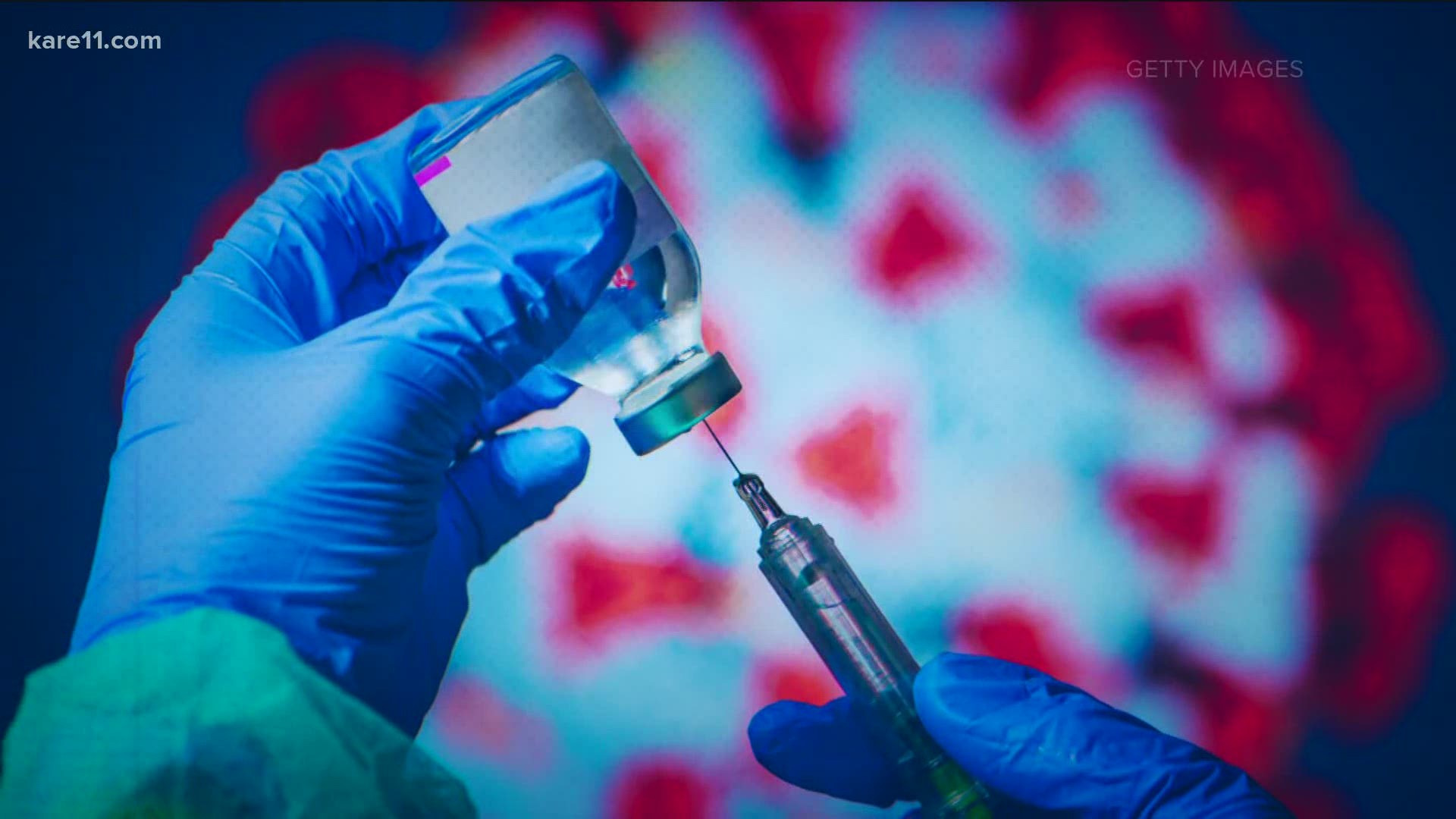Sunday, Jan. 24, 2021
- United States passes 25 million confirmed COVID-19 cases
- MDH: Nearly 250,000 Minnesotans have received at least one COVID-19 vaccine dose, more than 60,000 have received both doses
- Health officials say all skilled nursing facilities in MN have had first doses of COVID-19 vaccine
- New appointments at vaccine pilot sites to open up Tuesday, Jan. 26 at noon on mn.gov/vaccine
- President Biden moves forward on COVID-19 plan
- MDH launches new text, online survey program for initial COVID-19 case investigations
- People ages 12-25 returning to school, sports and activities now encouraged to get tested proactively
- Minnesota passes somber milestone of 6,000 COVID-19 deaths
11 a.m.
The Minnesota Department of Health (MDH) reported 1,196 new COVID-19 cases Sunday, along with 32 new deaths.
MDH's COVID-19 case definition includes both antigen testing and polymerase chain reaction (PCR) testing. Positive PCR test results are considered confirmed cases, while positive antigen test results are considered probable cases.
Sunday's new case total includes 1,012 confirmed cases and 184 probable cases.
The total number of Minnesotans who have tested positive for the virus since the pandemic began is now 454,989, with 18,967 of those as antigen test results.
MDH says 32 new deaths from the virus were reported. That pushes the total number of fatalities in Minnesota to 6,095.

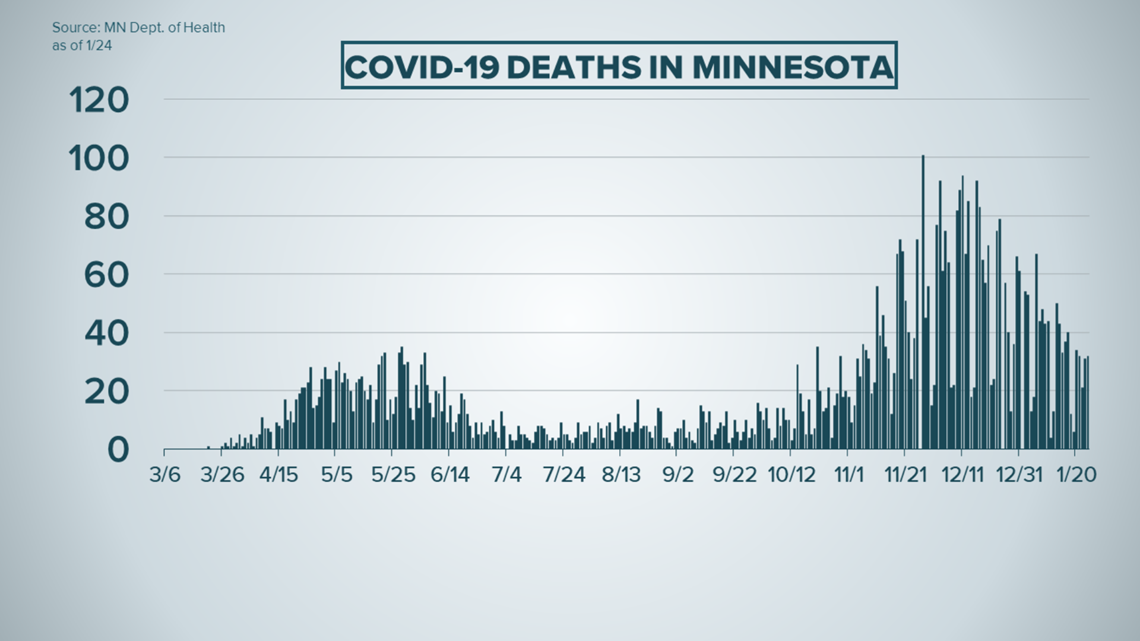
To date, 23,884 Minnesotans have been hospitalized with the coronavirus since the pandemic started, with 4,965 of them needing care in the ICU.
MDH reports that 437,827 people once diagnosed with the virus have passed the point where they are required to isolate.
Of those who have tested positive, people between the ages of 20-24 account for the most cases with 45,863 cases and three deaths, and ages 25-29 follow with 40,918 cases and six deaths. Those between 85 and 89 years old account for the highest number of fatalities in one age group with 1,163 out of 5,977 cases.
In terms of likely exposure to the coronavirus, MDH says 98,533 cases were the result of community transmission with no known contact with an infected person, and 91,563 had known contact with a person who has a confirmed case.
A total of 37,599 cases involved exposure in a congregate living setting,
7,760 were in a corrections setting, and 970 were in a homeless shelter. MDH data shows 18,127 were linked to an outbreak outside of congregate living or health care.
MDH says 30,523 cases were linked to travel. Health care workers or patients account for 13,545 of diagnosed COVID-19 cases. The source of transmission for 156,369 cases is still unknown or missing.
MDH has prioritized testing for people in congregate care, hospitalized patients and health care workers, which may impact the scale of those numbers. However, now MDH is urging anyone who is symptomatic or even asymptomatic to be tested. Testing locations can be found online.
Hennepin County has the most COVID activity in the state with 94,378 cases and 1,502 deaths, followed by Ramsey County with 40,624 cases and 748 deaths, Dakota County with 33,540 cases and 354 deaths, and Anoka County with 31,357 cases and 368 deaths.
Full data, including a breakdown of PCR and antigen test totals in some categories, can be found on MDH's website.
The Minnesota Department of Health has said repeatedly that the number of lab-confirmed cases is only the "tip of the iceberg" when it comes to the true number of COVID-19 cases in the state.
The state of Minnesota has set up a data portal at mn.gov/covid19.
The first case in Minnesota was confirmed on March 6.
Saturday, Jan. 23, 2021
2 p.m.
The Minnesota Department of Health (MDH) reported 1,565 new COVID-19 cases Saturday, along with 31 new deaths.
MDH's COVID-19 case definition includes both antigen testing and polymerase chain reaction (PCR) testing. Positive PCR test results are considered confirmed cases, while positive antigen test results are considered probable cases.
Saturday's new case total includes 1,399 confirmed cases and 166 probable cases.
The total number of Minnesotans who have tested positive for the virus since the pandemic began is now 453,808, with 18,627 of those as antigen test results.
MDH says 31 new deaths from the virus were reported. That pushes the total number of fatalities in Minnesota to 6,063.

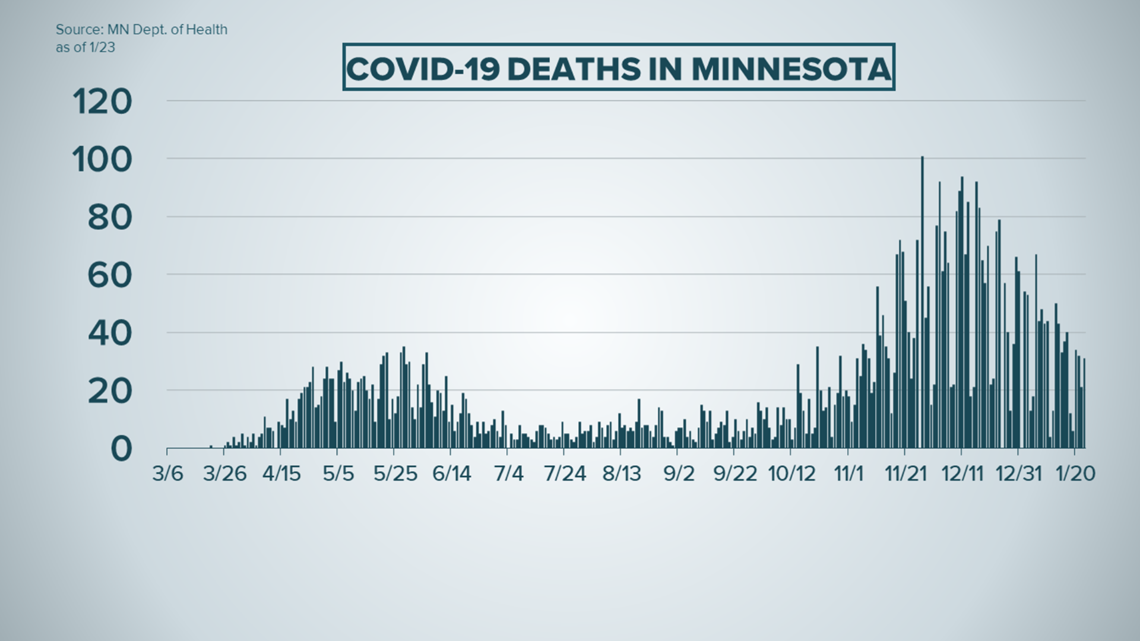
To date, 23,865 Minnesotans have been hospitalized with the coronavirus since the pandemic started, with 4,961 of them needing care in the ICU.
MDH reports that 436,544 people once diagnosed with the virus have passed the point where they are required to isolate.
Of those who have tested positive, people between the ages of 20-24 account for the most cases with 45,758 cases and three deaths, and ages 25-29 follow with
40,838 cases and six deaths. Those between 85 and 89 years old account for the highest number of fatalities in one age group with 1,153 out of 5,960 cases.
In terms of likely exposure to the coronavirus, MDH says 98,111 cases were the result of community transmission with no known contact with an infected person, and 91,160 had known contact with a person who has a confirmed case.
A total of 37,494 cases involved exposure in a congregate living setting,
7,757 were in a corrections setting, and 954 were in a homeless shelter. MDH data shows 18,063 were linked to an outbreak outside of congregate living or health care.
MDH says 30,376 cases were linked to travel. Health care workers or patients account for 13,516 of diagnosed COVID-19 cases. The source of transmission for 156,371 cases is still unknown or missing.
MDH has prioritized testing for people in congregate care, hospitalized patients and health care workers, which may impact the scale of those numbers. However, now MDH is urging anyone who is symptomatic or even asymptomatic to be tested. Testing locations can be found online.
Hennepin County has the most COVID activity in the state with 94,138 cases and 1,495 deaths, followed by Ramsey County with 40,509 cases and 748 deaths, Dakota County with 33,463 cases and 350 deaths, and Anoka County with 31,283 cases and 368 deaths.
Full data, including a breakdown of PCR and antigen test totals in some categories, can be found on MDH's website.
Wisconsin
Wisconsin's Department of Health Services (WDHS) reported 1,681 new cases Saturday, bringing the total number of cases since the pandemic began to 531,852.

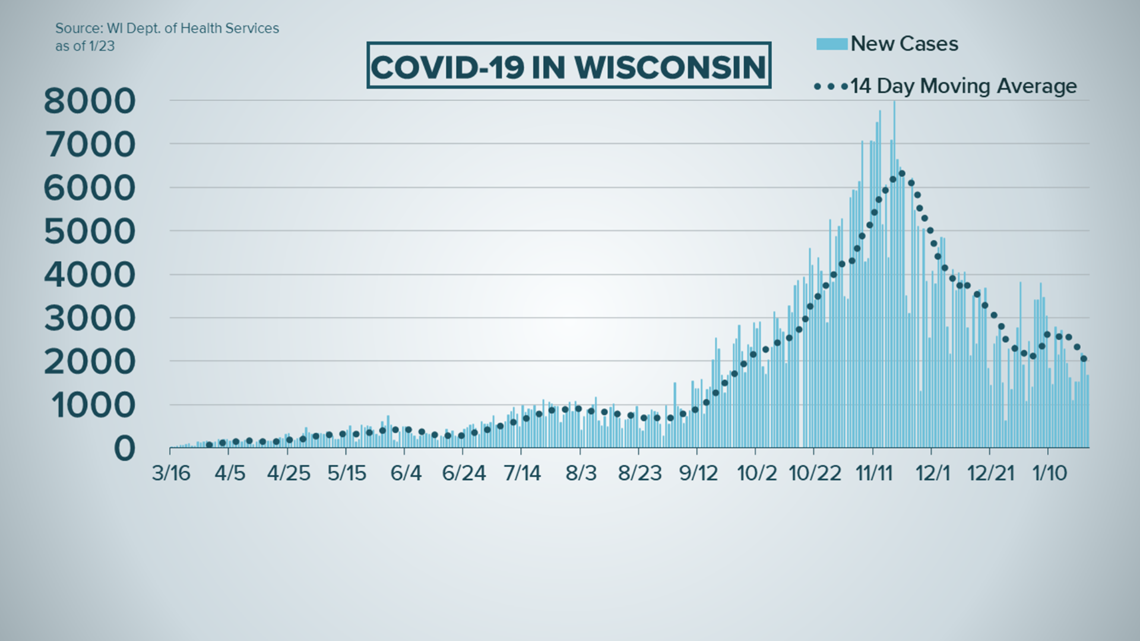
Health officials reported 42 new deaths on Saturday as the total number of fatalities rose to 5,685, approximately 1.1% of those who are infected with the virus.

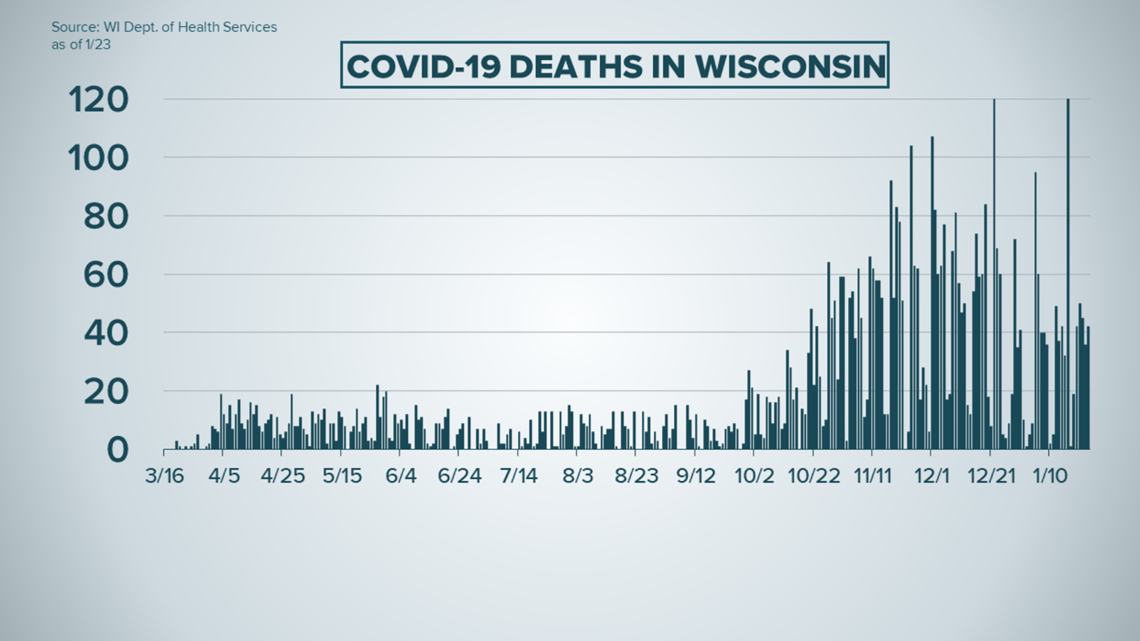
Due to high case numbers, Gov. Tony Evers issued a new emergency order mandating indoor face coverings on Friday, Nov. 20 that will last 60 days.
On Tuesday, Dec. 22 Gov. Evers announced that his administration has struck a deal with Vault Medical Services to provide free at-home COVID-19 saliva tests, according to the Associated Press. Anyone interested in a test can order one through the state Department of Health Services website starting immediately. Users must collect a sample as a Vault testing supervisor looks on via Zoom and then mail it back to a Vault lab using a prepaid label that comes with the kit. Results will take 48 hours to 72 hours.
Wisconsin health officials say a total of 23,625 people have been hospitalized from the coronavirus since the start of the pandemic, about 4.4% of the total number of people who have been diagnosed with the virus.
Of the confirmed cases in Wisconsin, 19% involve people between the ages of 20 to 29, 16% are between 30 and 39, 15% are between 50 and 59, and 14% are 40 to 49. An estimated 11% are between 10 and 19, and another 11% are between 60 and 69.
As of Saturday, Milwaukee County reported the largest number of confirmed cases with 93,118, along with 1,113 deaths. Waukesha County has reported 38,394 confirmed cases and 420 deaths, Dane County has reported 37,078 confirmed cases and 229 deaths, and Brown County has reported 28,770 cases and 190 deaths.
A more detailed breakdown of cases by county can be found on the DHS website.
The first positive case of COVID-19 coronavirus in Wisconsin was reported in a patient in Dane County in early February.
Friday, Jan. 22, 2021
2 p.m.
Gov. Tim Walz and Minnesota Department of Health (MDH) Commissioner Jan Malcolm held a media availability Friday while touring a long-term care facility that has begun vaccinating its residents.
“We still have a ways to go in COVID,” Walz said, but encouraged Minnesotans to look at the progress that's been made. "Four weeks ago we were getting our first doses into the state."
Malcolm said the first dose has been administered at the facility they toured Friday, Good Samaritan Society in New Hope. The second dose will be administered next weekend.
"We know that COVID has hit long-term care particularly hard," Malcolm said. "Not only the illness, the deaths, but the isolation."
Malcolm said the long-term care situation in Minnesota is better than it was about four to six weeks ago.
"We have once again seen cases in long-term care coming into a more manageable range,” Malcolm said.
As of the week of Jan. 10, Malcolm said Minnesota was 46th in the nation in number of COVID cases per resident in skilled nursing facilities, and 41st in the nation for deaths per population in skilled nursing facilities.
"The best tool going forward is vaccination,” Malcolm said.
Malcolm said the fact that so many long-term care residents have received a first dose of the vaccine shows that things are moving forward.
"That really demonstrates the progress that we’re making,” Malcolm said. “We believe that all skilled nursing facilities in Minnesota have now had their first doses.”
Assisted living facilities have also started vaccinating within the past week, she said, and should complete first and second doses in the next month or so.
Gov. Walz said he hopes that with the President Biden administration in place, the country will get into a more "predictable rhythm" with how many vaccine doses are being shipped to each state, and when.
Walz said to vaccinate the state effectively, about 80% of the population needs to receive the vaccine.
"We need to try and figure out how to get 3 million Minnesotans vaccinated to kind of reach the potential that we need to get to," Walz said. "We've got about a quarter-million right now. So at the rate we're at, this is where the frustration lies, it's not fast enough."
The governor said he thinks Minnesota will get close to that number in the next 90 days, if President Biden comes through with the 100 million vaccine doses he promised in the first 100 days of his administration. Walz said Minnesota leadership estimates they would get about 2 million of those doses.
"We are really a long ways along in vaccinating the most vulnerable, at least in the long term care," he said. He noted that Minnesota will be "a long ways along" in vaccinating teachers by next week.
But he acknowledged that older adults who don't live in facilities, and instead live on their own, are in urgent need of the vaccine, too.
'"Those folks are the next folks that we need to get to and get vaccinated," he said. "We're asking for Minnesotans' patience."
He acknowledged that the new, more contagious COVID-19 variants pose another challenge in terms of how deadly the virus will be before enough people get vaccinated to slow the spread.
"I feel like we're racing the clock to get 3 million people vaccinated as quickly as we can," he said. "At the current pace that's about 90 days to 100 days."
Malcolm said the 90-day estimate would be if Biden can indeed fulfill his goal of 100 million vaccines in his first 100 days in office. At the pace Minnesota is currently going, it will take four to five months just to get through the over 65 population, Malcolm said.
"We talk about immunizing for impact," Malcolm said. "Let's make the best use of the small number of doses we have to protect the most vulnerable and the people who care for them, and we are making good progress on that."
Malcolm said the next tiers of eligibility are a much bigger group.
"We could do it in six weeks with the right supply, and many months if we don't," she said.
Malcolm also referenced Johnson & Johnson and AstraZeneca as potential additional vaccines in the population, which represent "new twists."
"If we get more vaccines in the pipeline, more production out of the ones that we have, that's how we could meet or even eventually exceed that pace that the president is talking about," Malcolm said.
Walz said his administration understands it's frustrating for Minnesotans to not know where or when they can get their vaccine.
"We're doing everything we can to try and fix that," Walz said.
He said there is still a vast divide between supply and demand, with 2.1 million people in queue among adults over 65 and educators - and Minnesota on track to receive approximately 60,000 doses again next week.
Walz said that some of the doses listed on Minnesota's vaccine dashboard that appear to be "sitting on the shelf" are reserved for people who are scheduled to receive their second dose in the coming days. Right now the MDH website reports that Minnesota has administered 39.3% of the doses it's received so far.
Walz ended the news conference by thanking the long-term care facilities and workers across the state.
"These are the providers across Minnesota that have now got us in as strong a place as anywhere in the country," he said.
11 a.m.
The Minnesota Department of Health (MDH) reported 1,525 new COVID-19 cases on Friday, and 21 more deaths from the virus.
The 1,525 new cases of COVID-19 reported over the past day were based on results from 42,680 tests (39,611 PCR, 3,069 antigen) processed in private and state labs.
The total number of cases reported in the state now stands at 452,268.
The state vaccine dashboard says 214,050 people have received at least one dose of coronavirus vaccine, while 49,604 have completed the two-dose series.
Minnesota health care providers have received 522,875 shipped doses of vaccine, with another 149,800 coming to the state as part of a federal long-term care vaccination program. As of Friday, 39.3% of the doses shipped to Minnesota have been used.
Yesterday, the state began its pilot vaccination program, offering a very limited supply of vaccine doses to adults over 65, educators and child care workers. MDH said appointments are full this week, but will reopen for next week at noon on Tuesday, Jan. 26. Once open, appointments can be made here.
The state's death toll now stands at 6,032 since the start of the pandemic. Of those deaths 3,836, or 64% of them, are tied to long-term care or assisted living settings.

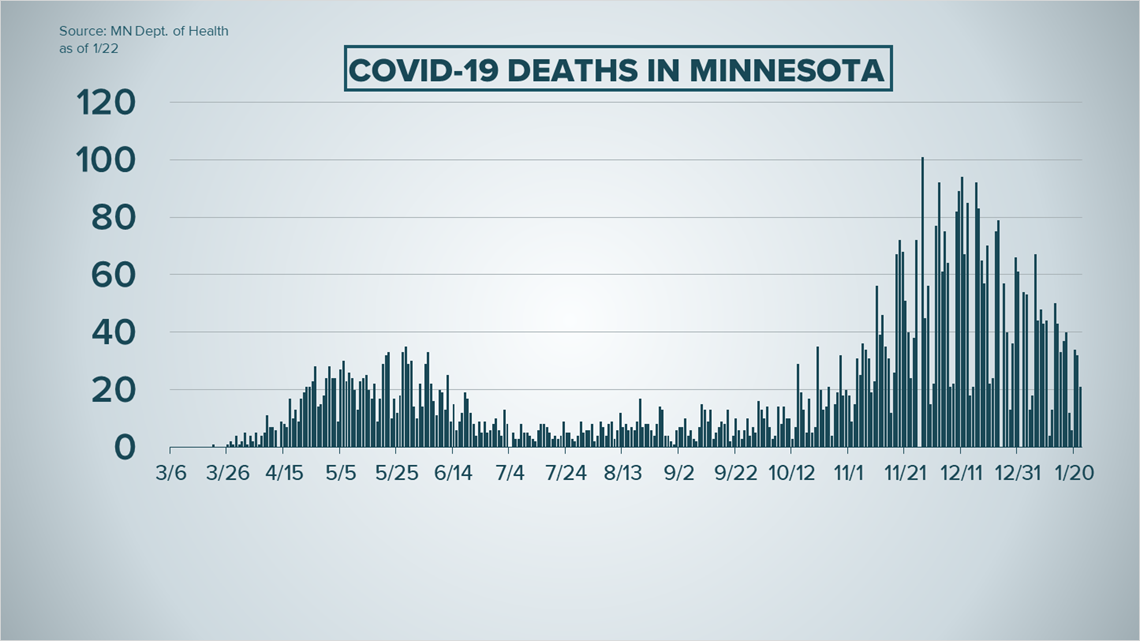
Total hospitalizations from the coronavirus now stand at 23,767, with 4,945 of those patients requiring care in the ICU.
MDH says 434,515 people who at one time tested positive for COVID no longer require isolation.
The largest number of deaths from the virus involves those between ages 85 and 89, with 1,144 in 5,948 diagnosed cases. Young adults 20 to 24 account for the largest number of cases with 45,625 and three fatalities, followed by adults 25 to 29 with 40,688 cases and six deaths.
Hennepin County has recorded the most COVID activity with 93,813 cases and 1,490 deaths, followed by Ramsey County with 40,370 and 746 deaths, Dakota County with 33,353 cases and 349 deaths, and Anoka County with 31,193 and 366 fatalities.
Cook County in northeastern Minnesota has the least COVID activity with 115 cases and zero deaths.
Thursday, Jan. 21
2 p.m.
The Minnesota Department of Health (MDH) is urging young people returning to more social interaction to get tested for COVID-19.
Assistant MDH Commissioner Dan Huff said on Thursday's media briefing call that with students beginning to go back to school and some restrictions loosening around Minnesota, the department is updating its testing recommendations.
MDH is now recommending that young people returning to schools, youth sports and extra curricular activities get tested for COVID proactively - especially those between the ages of 12 and 25. That includes college students returning to campus and anyone who regularly interacts with people outside their household.
"The bottom line is, that's a lot of new folks engaging with people they had not been previously interacting with," Huff said. "These new recommendations are in addition to anyone who is experiencing COVID symptoms, anyone who has been exposed to someone who has tested positive, and anyone who is working at places that remain open during the pandemic."
Huff said that recommendation does apply to all young people going back to school, including those under age 12. However, he said, MDH focused on young people ages 12-25 because they tend to be more "active on their own."
"They may be doing more things without mom and dad," he said. "Therefore they're more social, and interacting with more people outside their household pod. ... Yes, it is important that all children get tested, but the reason we're focusing on that one age cohort is because of their social activity."
Huff said every school district is now required to offer COVID testing for their on-site staff every other week. The state provides the saliva test kits and training on how to administer them. Huff said school employees are not required to take the tests, but the schools are required to offer them. So far more than 17,000 school staff have been tested through this program, with a .36% positivity rate, Huff said.
MDH Commissioner Jan Malcolm and Infectious Disease Division Director Kris Ehresmann also spoke on the briefing call.
Malcolm reported Thursday that the rate of cases and deaths across the U.S. continues to be "relentless."
New cases in Minnesota have been fairly steady the last two days.
"Yesterday marked four weeks after the Christmas holiday and three weeks after the new year's holiday," Malcolm said. "Thankfully the evidence suggests that we've already seen our post-holiday spike and that it was a modest and manageable one."
Malcolm said Minnesota could still see some impact from new year's holiday gatherings.
The test positivity rate has dropped to 5.1% in Minnesota, Malcolm said. Hospital bed use continues to decline a bit, Malcolm reported, but that statistic is a "lagging figure" and could go up due to a bump in cases in recent days.
Malcolm acknowledged that Minnesota passed the 6,000-death milestone as of the new numbers reported Thursday.
Minnesota's vaccine dashboard shows that as of Sunday nearly 246,000 total doses have been administered, and almost 627,000 total doses have been allocated to Minnesota by the federal government. Almost 610,000 show in the CDC system as having been shipped to Minnesota, but Malcolm reminded the public that the tracking system is complex. The vaccines shipped to Minnesota include doses that are shipped for the CDC's federal pharmacy partnership program for vaccinations in long-term care. She said the number of doses fully delivered to Minnesota for the state to administer is closer to 300,000.
"While we continue to push for more vaccines from the federal government," Malcolm said, "we're busy building up the infrastructure in Minnesota so that we're ready to get out large amounts of the vaccine as soon as those become available from the federal government."
MDH Infectious Disease Division Director Kris Ehresmann gave more details on the department's Thursday announcement that new online survey to do the initial case investigation after someone tests positive for COVID-19.
Instead of receiving a phone call and being interviewed by a case investigator, people will receive a text message asking them to participate in a survey. Once they reply with their email address they'll be able to answer the initial questions about their case, about symptoms and testing dates, online. Anyone who does not reply to the text will still receive a phone call.
In response to a question about the limited availability of appointments through the state's new pilot vaccine program, Malcolm stressed that the community vaccination sites are meant to supplement other methods of distribution. She said that most people will be getting their vaccines from health care providers or pharmacies. Malcolm said the state wanted to set up the community sites to pave the way for more mass vaccination possibilities as the supply ramps up.
11 a.m.
The Minnesota Department of Health (MDH) reported 1,292 new COVID-19 cases on Thursday, and 32 more deaths from the virus.
According to MDH, 1,087 of those reported cases came from PCR tests, which are considered "confirmed." Another 205 came from antigen tests, considered "probable."
Testing numbers for the past 24-hour reporting period were more than double the previous one.
Thursday's reported death toll brings Minnesota's total fatalities since the pandemic began to 6,011, passing the somber milestone of 6,000 deaths for the first time.
Community transmission with no known contact with a confirmed case continues to be the most common "likely exposure" source, with 97,304 of Minnesota's cases so far. The second most common source is known contact with a confirmed case, at 90,424 cases.
Minnesota's hospital capacity is greater in general than when demand was at its peak in November and early December. While ICU numbers are dropping, regular hospital bed use is rising.
ICU bed use due to the virus is the lowest it's been since September, with only 98 beds in use for COVID-19 patients. Regular beds, however, are being used for 460 COVID patients as of Jan. 20, the latest data available.
In the metro, 8.3% of staffed ICU beds are available, which is out of the red danger zone. Only 3.7% of staffed non-ICU beds are available in the metro, still low enough to remain in the red zone.
After launching online vaccine appointments for an expanded group of Minnesotans including adults over 65, educators and child care workers, MDH said appointments are full for this week.
However, people who are eligible are encouraged to "check back soon for more information about future appointments." MDH and Gov. Tim Walz have warned that there is a "very limited supply" of doses.
RELATED: MN officials: More than 10,000 COVID-19 vaccination appointments set up in new pilot program
According to MDH's publicly available vaccine data, as of Monday, 203,839 Minnesotans have received at least one dose of a COVID-19 vaccine, and 41,984 people have received both doses.
Walz has called on the federal government to buy more doses of the vaccine, and newly sworn-in President Joe Biden has a goal of distributing 100 million vaccines in his first 100 days in office.
KARE 11’s coverage of the coronavirus is rooted in Facts, not Fear. Visit kare11.com/coronavirus for comprehensive coverage, and kare11.com/vaccine for answers to all of your questions about the race to get the U.S. vaccinated. Have a question? Text it to us at 763-797-7215. And get the latest coronavirus updates sent right to your inbox every morning. Subscribe to the KARE 11 Sunrise newsletter here. Help local families in need: www.kare11.com/give11.
The state of Minnesota has set up a data portal online at mn.gov/covid19.

